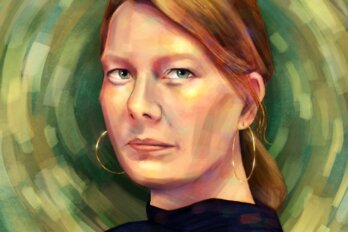Near the end of bestselling author Kelley Armstrong’s latest thriller, This Fallen Prey, homicide detective Casey Butler has two men at the mercy of her gun, deep in the Yukon wilderness. Both men are accusing each other of the same heinous crimes, and Casey craves a simple course of action: decide who is guilty and shoot him. One man is Oliver Brady, a suspected serial killer and recent prison escapee; the other is Oliver’s stepfather and most adamant accuser, Gregory Wallace. But Gregory’s eager participation in Oliver’s recapture—the outcome of a blood-spattered chase through the woods—has caused Casey to question his innocence.
She hopes her weapon will shock a confession from either man. (In the middle of the woods, and up against two large men, a straightforward arrest won’t work.) But, in the heat of the action, Casey hesitates: Does the possibility of eliminating the right guy outweigh the risk of killing an innocent person? Ultimately—despite both men trying to manipulate her with flattery and insult—Casey refuses to be the “judge, jury, and…executioner,” and she decides to bind and gag the two men.
The dilemma Casey faces is typical of a dramatic thriller like This Fallen Prey, but her response also hinges on a Dumbledore-esque piece of wisdom that is knitted throughout the book: there is usually a difference between what is right and what is easy. Throughout This Fallen Prey, the third book in Kelley Armstrong’s popular Rockton series, Casey is trying to prove her value to a culture that considers her gender and small size (she’s barely five foot two) to be incompatible with authority. In Rockton, a fictional town in the Canadian North, civilians—whether on the run from a criminal or a criminal themselves—abandon their past lives and construct a new identity from scratch. The town can’t be found on any map; it has neither cell nor internet service. It is accessible only by plane, and any arrival or departure requires the approval of the local council. The drama and action of the Rockton series make it a compelling read, but the books also offer something deeper to readers who know where to look, pushing them to consider identity politics, feminism, and the divergent ethical principles (utilitarianism v. moral absolutism) present in the criminal-justice system.
Armstrong has published more than forty books since 2001, including seven series spanning a variety of genres—thriller, fantasy, mystery, romance, young-adult fiction, and various cross-pollinations. She is also a New York Times bestselling author, and according to a list published by the CBC, she has penned three of Canada’s 150 bestselling books. Armstrong is perhaps best known for Women of the Otherworld, a thirteen-book series that follows the world’s only female werewolf, who leaves her pack in favour of pursuing a “normal” life in Toronto. Space adapted these novels into the television series Bitten, which ran for three seasons, from 2014 to 2016.
But if your taste in books is dictated by Canada’s literary authorities—the CBC’s Canada Reads, the Giller Prize jury, or university creative-writing departments—you’ve probably never read a book by Kelley Armstrong. She writes commercial or genre fiction, which prioritizes entertainment value and narrative plot over complexity of style and ideas. Her books aren’t intended to garner critical reviews or win a Governor General’s Literary Award; they don’t do explicitly the same kind of cultural legwork—elevating marginalized voices, exposing hard truths, examining our national identity—that such institutions set out to reward. “The types of people I appeal to are not the people who read one book a year,” says Armstrong. “It’s the people who read one book a week.” Much like Stephen King’s supernatural thrillers or Stephenie Meyer’s romantic Twilight series, Armstrong’s novels are accessible to anyone with average reading skills, and she isn’t interested in engaging readers in tough discussions if that’s not what they want. As she says: “My books are not broccoli.”
Armstrong grew up reading everything she could get her hands on—from classics such as Little Women to popular children’s series such as the Hardy Boys—but she didn’t originally plan on becoming a full-time author. After earning a psychology degree from Western University in 1991, she returned to college and began a career in computer programming, which gave her a steady income. She wrote after work and during weekends, then sent the manuscripts to agents and publishers for consideration. Her fourth book, Bitten, was the first to be accepted. Now she writes an average of two books a year.
I recently met Armstrong over Skype, somewhere in the cyberspace between my East Vancouver apartment and her home in rural Ontario. She was wearing a blue T-shirt with “Fight Like a Girl” and a picture of Wonder Woman on the front. In the back-field cabin behind her house, which she shares with her husband and two of three daughters (the third is twenty-five and no longer at home), she spends about six hours writing every day. Her novels—This Fallen Prey included—all have a common theme: female rage and its monstrous manifestations. Beneath the moon, somewhere in a dark forest, or on backroads of rural Ontario, women bare teeth, point guns, and refuse to let their abusers win. (It’s no surprise, then, that about 90 percent of Armstrong’s readers are girls and women.)
Our national literary culture tends to focus its attention on “CanLit,” the subset of Canadian writing that prioritizes artistry and intellect and tackles distinctly Canadian issues. The “literary” label is not always an amorphous cultural idea, but an institutional standard: the Canada Council (which selects the Governor General’s Literary Awards each year) defines a literary book as “a print publication driven by ideas, themes, and opinions of the writer(s)” and considers titles that contain “minimal critical content” to be ineligible.
This year’s Rogers Writer’s Trust Fiction Prize—another prestigious CanLit award—went to David Chariandy’s Brother, a coming-of-age story set in a suburb of Toronto that was described as “a pitch-perfect song of masculinity and tenderness, and of the ties of family and community.” Chariandy’s critical content is front and centre throughout the novel, pushing readers to examine their own lives. But, with most of the literary world’s focus on CanLit, we rarely pause to acknowledge fantasy or commercial fiction—which is too bad, because reading a book like This Fallen Prey with the purpose of sparking critical thinking can, in fact, be surprisingly productive.
Living in Rockton is eerily parallel to life in the digital age: characters forget their real-world self and invent a new one. If you’re a psychopath posing as an average Joe in Rockton, you might navigate your life in a similar way to an anonymous Twitter user—with little fear that your actions will have repercussions beyond that setting. “You’re going to see the best and worst of people in Rockton,” says Armstrong. Casey shot and killed her boyfriend when she was eighteen. The boyfriend was pure scum—a victim blamer who abandoned her after a brutal sexual assault—but should she have pulled the trigger?
Trust in one’s own judgement is a recurring theme in the novel. Casey is tasked not only with keeping Oliver locked up but also with pacifying the townspeople about his presence. After Oliver escapes and flees to the forest with a hostage, Casey must overcome a deep sense of guilt in order to track him down and restore peace in Rockton. When it becomes clear that an inside accomplice has been helping Oliver, Casey finds herself questioning her friends—people who are both familiar and foreign to her, given their hidden pasts. Who is helping Oliver and why? Good people can do bad things, but distinguishing between cowardice, compliance, and courage (especially in the face of threats) isn’t always easy.
In light of current discussions around consent (you bet I am talking about #MeToo), differentiating between appropriate behaviour, questionable behaviour, and criminal behaviour feels more urgent than ever, and so the questions prompted by This Fallen Prey—namely, “Is this considered okay and in whose eyes?” and “Will I be able to justify this to myself and to others?”—are especially productive. A similar sentiment was echoed by Sarah Silverman last year, in a monologue following sexual-misconduct allegations against her friend, comedian Louis C. K.: “I love Louis. But he did these things. Both of those statements are true.”
At one point in the series, Casey may have thought the same thing of her own husband, Dalton, a fellow police officer who first seemed to be a classic “bully with a badge” because of his excessively rough treatment of citizens. The messy, duplicitous nature of people is something Armstrong writes well. She may not be in direct dialogue with Sarah Silverman or #MeToo, but her work constantly pushes us into that grey area—a place we should all get to know better if we’re going to see the world beyond the system of binaries (good v. bad, left v. right, masculine v. feminine) warred about on Twitter.
Most of my friends and I are “literary folk.” Many of us have master’s degrees in creative writing, and we pride ourselves on our knowledge of books. Yet none of my friends had heard of Kelley Armstrong until I brought her up. Since reading This Fallen Prey, I’ve thought at length about this lack of knowledge. I wish I had read Bitten when I was a teenager. As a fifteen-year-old, I could have related to a character whose body transformed in a way she couldn’t control. Today, I don’t typically find myself drawn to fantasy, thriller, sci-fi or anything that feels “larger than life,” but sometimes I wonder if that’s because the inclination to read those books has been trained out of me by academia. I was fairy-tale obsessed as a kid; now I rarely read anything that isn’t introspective modern realism.
“Quick reads,” like mystery, romance, and fantasy novels, have long been associated with lower intellectual value. They are, as critic Edmund Wilson wrote in 1945, “a kind of vice that, for silliness and minor harmfulness, rank somewhere between crossword puzzles and smoking.” Margaret Atwood even famously stated in 2003 that Oryx and Crake and The Handmaid’s Tale were “speculative fiction” and not “science fiction” because “science fiction has monsters and spaceships.” When Armstrong attended Western University for psychology in the early ’90s, she wanted to take a creative-writing course. She applied for a workshop where the ten best candidates were accepted each term, on the basis on a short story submission. Despite having already won contests and earned praise for her inventive stories, “I gave them a horror story and didn’t even make the waiting list,” she says.
And yet, today, Armstrong is the sole financial provider for her family, and about 99 percent of Armstrong’s income comes from book sales—an impossibility for most CanLit writers, who often rely on at least one other job (teaching, bartending, walking French bulldogs) for money. A book described as “a pitch-perfect song of masculinity and tenderness” (Brother) might attract enough people to fill a café, while a “spine-tingling thriller from the bestselling master of edge-of-your-seat stories” (the blurb for This Fallen Prey) could sell out a stadium for a reading.
How can there be such disparity between the books that we talk about in literary circles and the ones that seem to actually find popular success? The categories that book critics rely on may not be as rigid as they seem. In fact, it’s helpful to look at commercial and literary fiction as existing within a Venn diagram. In the overlap are books like Mary Shelley’s Frankenstein (gothic horror but also classic literature) and Yann Martel’s Life of Pi—a global bestseller turned Oscar-winning film that has the gripping plot of a commercial novel (a horrible storm leaves a young boy stranded on a dinghy with a tiger) with the complexity of a literary work (is the tiger a figment of the boy’s imagination?). More recently, Celeste Ng’s Little Fires Everywhere is both a New York Times bestseller and a critical darling, called a “wrought meditation on the nature of motherhood” by the San Francisco Chronicle. Amazon categorizes it as “genre fiction”; Indigo as “literary.”
Armstrong writes about what fascinates her (girls with guns, psychopaths in the woods) and has no plans to compromise these interests in favour of more national recognition. “There’s a misconception that if you’re doing my kind of writing…you’re aspiring to write literary fiction. Definitely not,” Armstrong says. “Getting to write exactly what I want and make a living out of it is amazing.”





